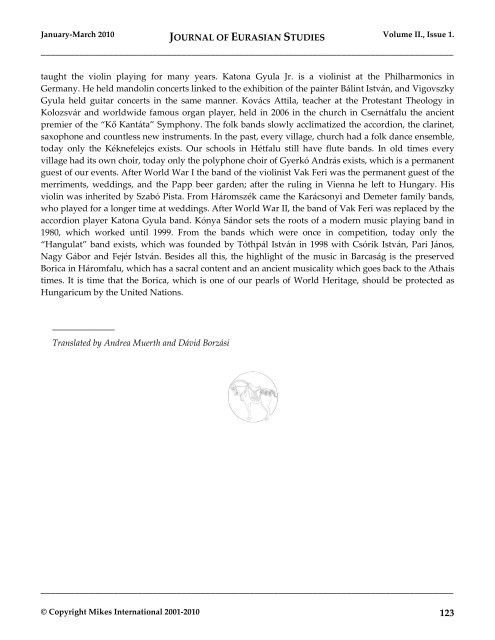EurasianStudies_0110..
EurasianStudies_0110..
EurasianStudies_0110..
Create successful ePaper yourself
Turn your PDF publications into a flip-book with our unique Google optimized e-Paper software.
January-March 2010 JOURNAL OF EURASIAN STUDIES Volume II., Issue 1.<br />
_____________________________________________________________________________________<br />
taught the violin playing for many years. Katona Gyula Jr. is a violinist at the Philharmonics in<br />
Germany. He held mandolin concerts linked to the exhibition of the painter Bálint István, and Vigovszky<br />
Gyula held guitar concerts in the same manner. Kovács Attila, teacher at the Protestant Theology in<br />
Kolozsvár and worldwide famous organ player, held in 2006 in the church in Csernátfalu the ancient<br />
premier of the “Kő Kantáta” Symphony. The folk bands slowly acclimatized the accordion, the clarinet,<br />
saxophone and countless new instruments. In the past, every village, church had a folk dance ensemble,<br />
today only the Kéknefelejcs exists. Our schools in Hétfalu still have flute bands. In old times every<br />
village had its own choir, today only the polyphone choir of Gyerkó András exists, which is a permanent<br />
guest of our events. After World War I the band of the violinist Vak Feri was the permanent guest of the<br />
merriments, weddings, and the Papp beer garden; after the ruling in Vienna he left to Hungary. His<br />
violin was inherited by Szabó Pista. From Háromszék came the Karácsonyi and Demeter family bands,<br />
who played for a longer time at weddings. After World War II, the band of Vak Feri was replaced by the<br />
accordion player Katona Gyula band. Kónya Sándor sets the roots of a modern music playing band in<br />
1980, which worked until 1999. From the bands which were once in competition, today only the<br />
“Hangulat” band exists, which was founded by Tóthpál István in 1998 with Csórik István, Pari János,<br />
Nagy Gábor and Fejér István. Besides all this, the highlight of the music in Barcaság is the preserved<br />
Borica in Háromfalu, which has a sacral content and an ancient musicality which goes back to the Athais<br />
times. It is time that the Borica, which is one of our pearls of World Heritage, should be protected as<br />
Hungaricum by the United Nations.<br />
______________<br />
Translated by Andrea Muerth and Dávid Borzási<br />
_____________________________________________________________________________________<br />
© Copyright Mikes International 2001-2010 123

















